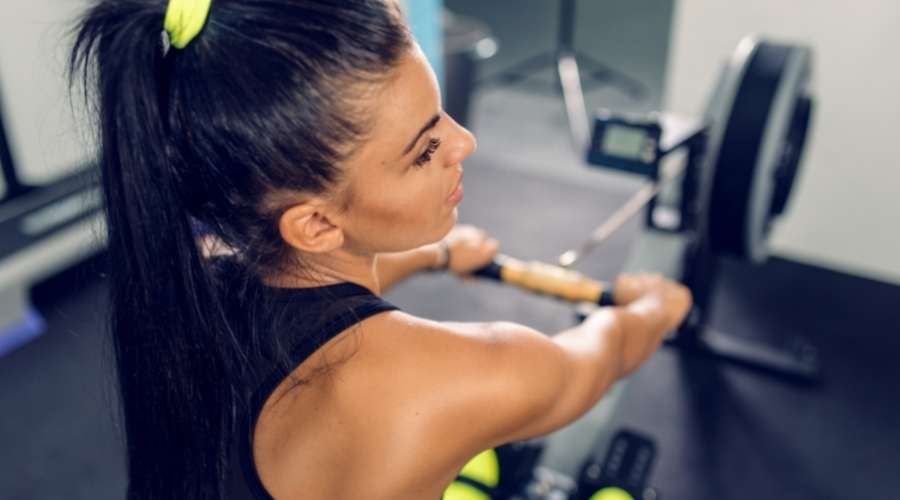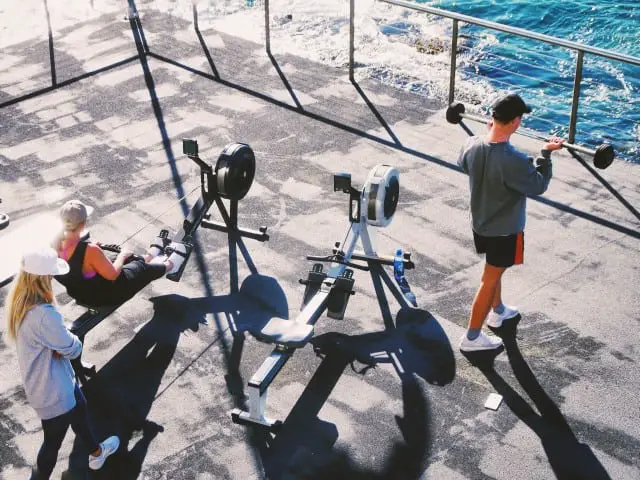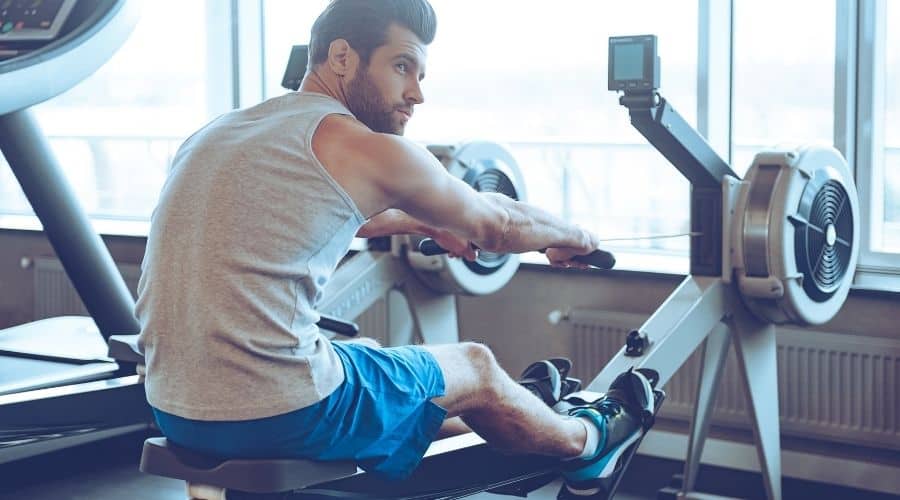If you’ve always been used to rowing for meters, rowing for calories in CrossFit can seem to come with rather a steep learning curve.
After all, measuring our output in meters is something many of us learn right at the start of our training. We’re familiar with it, we know precisely what works, how to perform at our best, and how to track that performance, which is no doubt why many CrossFitters opt to stick with it.
Yet since the CrossFit Open Games 18:1 brought calorie rowing back to the forefront, we’ve seen even some experienced veterans of the sport switch things up, only to find that this approach to rowing requires a different kind of effort, focus, and ways of tracking.
Not that it has to be so confusing.
Whether you’ve been hustling to get your 18:1 scores in by the deadline and need a little help figuring things out, or whether you’re simply looking to diversify your favorite WOD, this guide is for you.
Below, we’ll explain exactly why rowing for calories in CrossFit is different from rowing for meters and outline what you need to know in order to do it effectively.
What’s the Difference Between Rowing for Calories vs. Rowing for Meters?

The key difference between CrossFit rowing for calories versus rowing for meters is that when you aim for a calorie-based record, your power output will be linear, while recording for meters results in a negative exponential, meaning that increasing your power by a specific percentage doesn’t improve your pace by that same percentage.
To help us better understand this, we’ll use the example of training on the Concept2 Model D Rower, partly because it’s one of the best in the business, but mostly because Concept2 is the only brand that is universally accepted by all officially sanctioned CrossFit competitions, including the aforementioned Open Games.
If you’re not familiar with this model, here’s our guide to the Concept2 Model D Rowing Machine and how it compares to the Concept2 Skierg Machine.
For now, though, we’re going to consider how the Model D’s in-built Performance Monitor 5 handles calorie vs. meter output.
Calorie Monitoring is Not Precise
The first thing to note is that the number of calories displayed on your rower isn’t necessarily the exact number of calories you’ve burned during your workout.
Instead, it’s a means of measuring performance that is calculated using a formula based on the number of calories a person weighing 175 lbs would have burned when using the Concept2 during a set period of time.
In other words, if you row for an hour and Concept2 tells you that you’ve burned 700 calories, the actual number of calories you’ve burned may be higher or lower depending on whether you’re heavier or lighter than 175 lbs.
Still, while it doesn’t necessarily give you an accurate indication of precisely how many calories you’ve burned, it’s still an effective way to see the results of your efforts and manage your performance, especially when you consider the linear vs. negative exponential concept we just mentioned a moment ago.
With rowing for calories, increasing your power output results in a linear, equal calorie increase.
If you row with a power output of 1,000 calories per hour (Cals/ph) over a five-minute period and that results in 50 calories burned, then double your efforts 2,000 Cals/ph, you’ll see that calorie count likewise double to 100.
With meter racing, however, increasing your power output by that same 50% may only result in a 25% increase in your rowing pace.
Does CrossFit Rowing for Calories vs. Meters Matter in Training?
The approach you take in training only makes a major difference when it comes to the type of workout you’re doing.
If you’re solely focussing on a quality rowing WOD, your technique and overall approach won’t be any different regardless of how you measure your performance. The only thing you’ll need to be mindful of is how long it’s going to take you to row to achieve your target so that you can set a good pace.
If you’re doing a mixed workout, then it does make a difference as you’ll need to focus more on effective transitions between exercises and consider the importance of setting a good pace.
To put this simply, it makes more sense to grow faster over shorter distances when rowing for calories, whereas CrossFitters rowing for meters benefits from keeping a steady pace without increasing the speed so as not to affect their performance (through forced rest periods, etc.) during the rest of the workout.
3 Crossfit Rowing for Calories Tips

‘Ghost Calories’ and Measuring Your Workout
One of the main reasons why many CrossFit competitions opt for calories over meters is that rowing for calories often gives a much more accurate reading of the final output that is achieved once an athlete stops.
When you row for meters, your performance is constantly updating, which means that, after your final pull, it takes a moment for the Performance Monitor 5 to calculate your output accurately.
Ultimately, this is going to add what are known as “ghost meters” onto the end of your workout, which can make it tricky for competition judges to accurately note what a CrossFitter’s final output was at the moment they stopped.
When measuring calories, there is also the chance that “ghost calories” can occur, but since calories are measured only in whole numbers rather than decimal numbers, you could well end up in a scenario where any “ghosts” you do get don’t push you up to the next calorie.
In other words, if the monitor is displaying 49 calories and you stop, you may not have enough “ghost calories” to change that number to 50.
Ultimately, this does affect how you end your workout.
If you’re used to rowing for meters and relying on a few extra “ghost meters” to push you up to your target number, you may need to change tactics and pull hard until you reach your calorie target rather than stopping too early only to find that “ghost calories” don’t get you to your target and thus you have to keep going.
Related: What are the best rowing machines to use for cardio and CrossFit?
Efficiency Matters
The most important thing to note in all this is that rowing for calories in CrossFit doesn’t require a change in your actual rowing technique.
Really, what matters the most is efficiency and improving the way you connect with the rower, driving your legs forcefully into each stroke and letting them do the bulk of the work while your arms retain a relatively loose grip and guide the movements.
Likewise, the whole of your upper body should remain pretty loose and easy, as tensing up the arms, shoulders, and chest not only throws you off your position but can result in an unnecessary waste of energy.
Then, when pushing back into the recovery part of the stroke, move with your rear first, an approach that loads up the hamstrings, ready for an even more powerful leg drive on the next stroke.
Keep these tips in mind, and you’ll improve the overall efficiency of your workout as you work towards that calorie count.
Consider Pacing
Finally, we’d be remiss if we didn’t mention the significant difference pacing makes when rowing for calories.
If you were rowing for meters, it doesn’t make much sense to move any faster as you’ll still have to cover the same distance and risk burning out before the next exercise.
With calories, which are measured in watts rather than distance, the harder you work, the better your output, meaning you’ll benefit from pushing that much harder and faster to get better results.
Frequently Asked Questions
How do I burn more calories while rowing?
Start with a steady stroke at a comfortable pace and increase that pace by one stroke per 30-60 seconds until you’re rowing at 30 strokes per minute. The gradually increased effort will ultimately help you to burn more calories.
How far is 100 calories on a rower?
100 calories is around 1,200 – 1,800 meters, depending on how hard you work.
How many calories does 20 minutes of rowing burn?
20 minutes of rowing at medium-high intensity can burn over 300 calories.
CrossFit Rowing for Calories: The Final Word
While rowing for calories can seem like it requires something of a steep learning curve, the important thing to remember here is that your actual rowing technique doesn’t need to change much, if at all.
Instead, the fact that your output is measured in power (in watts) rather than distance simply means that the only thing you really need to focus on is improving your efficiency and upping your usual intensity, as you’ll benefit much more from working harder and faster than you would if you were measuring your performance in distance.
Keep that in mind, and remember not to rely on “ghost calories” to get you to your target, and you’ll have no problem as you adapt to a new way of rowing no matter whether you’re competing or simply switching up an old routine to prevent it from feeling stale.

